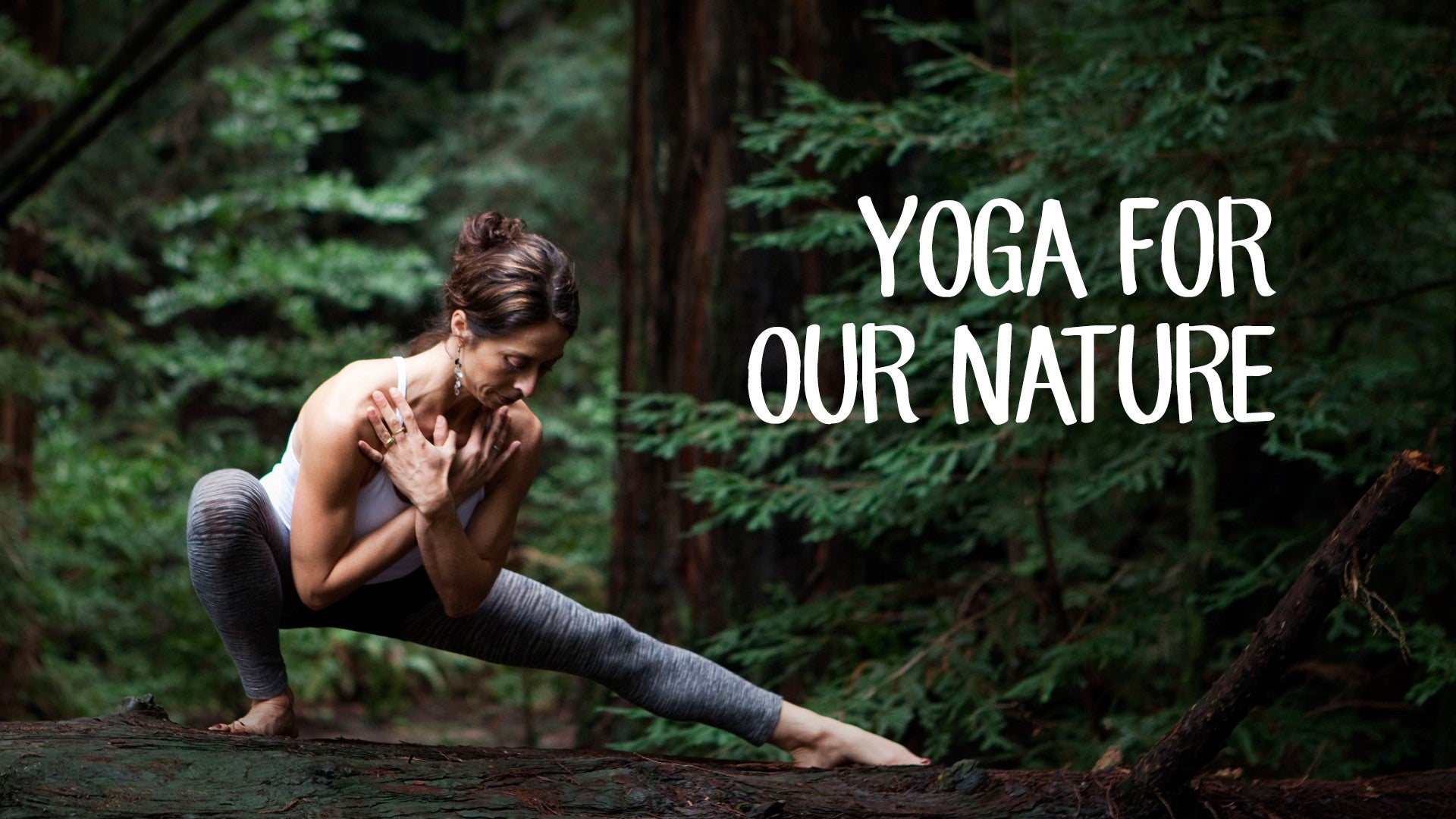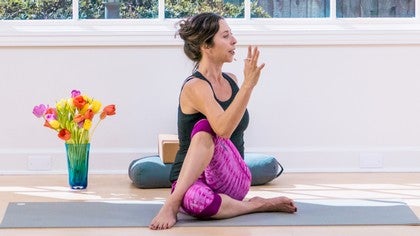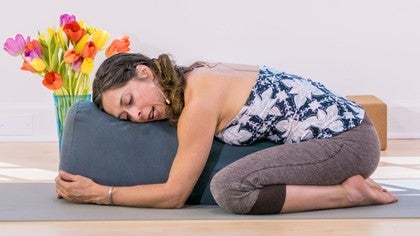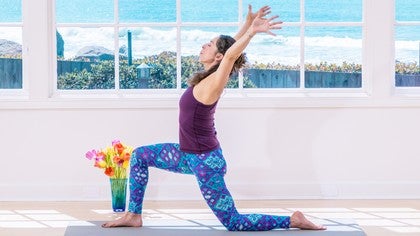Description
Transcript
Read Full Transcript
(waves crashing) Welcome to the First Pillar Talk, which is on digestion, and we'll move into a practice at the end of this introduction piece. What I'd like to say is... What I'd like so share is an Ayurvedic proverb that goes like this. "When diet is wrong, medicine is of no use. "When diet is correct, medicine is of no need." So in this section of the diet pillar, we're trying to discover for our self what's the right diet for you, so that food really becomes your medicine.
And there's no food that's considered bad or good in the system of of Ayurveda. It's just a matter of asking yourself the question. Can I digest this? Is this good for me? And we start to discover that what is medicinal for one person can be poisonous for another person.
So if we start to look at how to determine whether or not you're able to digest food, well, often times, we need to start bringing more mindfulness to the experience of eating. So when we're paying more attention, we'll start to notice, for example, what's happening in the body after we eat food, which can help you discover whether the food is digestible or not. Different kinds of feedback might happen in your body, and we would try to eliminate as much as possible any acid reflux, bloating, nausea, those types of conditions that happen after you eat. Another thing we would try to observe after you take in food is what your energy level is like. And we try to work toward a day where the energy level is stable throughout the entire day, which usually is a good sign that the food you're eating is right for your constitution.
And another factor that we try to look at is whether you're having a regular appetite. So it's often the case that if you're having regular appetites throughout the day that you have a normal Agni, as we would say, a normal digestive fire. For Pitta people, they tend to run a little bit hotter, and their digestive system also tends to be strong, and they may be hungry more frequently than the other constitutions somebody who's Vata might notice they have irregular appetites. Somebody who's more Kapha might notice that their appetite is really slow to form, especially in the morning time. They might not actually be hungry until 11 o'clock in the morning or even noon is not uncommon for a Kapha constitution.
So, looking at your appetite is one way to also notice is the food that you're eating digestible at a reasonable rate. Last but not least, we want to look at the tongue as a place where, with the Ayurvedic yoga is called, Ama accumulates if food that you're eating is not digested well. And Ama often looks different for different constitutions, but in general, there is more of a coding on your tongue. And the coding on your tongue, we think of it as mere reflection for what's happening in your GI track. So if you're tongue has a lot of coding on it, often there will also be a foul smell in the mouth, which all lead to undigested food or food not digesting well.
So those are some of the things you look at to identify. Is the food you're eating working for your body? And then what we try to do is to really protect your digestive fire. And the Ayurvedic yoga think of your stomach area having a little fire in it. So if you can imagine a little camp fire.
Things that protect your digestive fire, called Jatharagni, are by eating only when you're hungry, and then when you're no longer having hunger signals that you stop eating. So that's one way to protect your fire. If we put too much cold liquid in the stomach around meal times, we put out the fire. If we put too much food into the stomach, we put out the digestive fire. So those are really two common practices that you use to protect your digestive fire.
And what's challenging is that we need to do that multiple times in one day. So it's a life-long practice, tending to our digestive fire. So there are a couple of other things you could do to protect your digestive fire, and that's by eating simple food combinations. If you're having also any digestive disturbances, having soup, which is often really easy to digest. So we encourage those two things.
As well as taking a little time to rest after you eat food, so you get to digest a little bit more before you get busy in your day. So those are few ways to protect the digestive fire. And then if wanted to think about ways to increase your digestive fire, if your symptoms are irregular or perhaps slow, ways that you can increase your digestive fire are through exercise, through yoga, through being outdoors and exposed to sun. Getting exercise out in the sun is a great way to absorb that solar energy and heat. And then also we increase the digestive fire through warming spices and herbs.
And again, each Dosha has its own herbs that we would take in to increase the digestive fire, but those are some of the common ways, if there's any irregularity with your digestive system that we would lean toward using Ayurveda. And we're gonna step into now the face of hatha yoga, and trying to do some yoga postures to relax the body enough that we can start to move more energy through the stomach area, through the organs, and hopefully where our attention goes our prana follows, and we start to stimulate the digestive system and digestive track. So let's start now, dropping into some of the yoga postures that might be helpful to improve digestion. What we'll need for our practice today is a bolster and a block. and we'll begin with a bolster underneath your back.
If you find a spot where you can put your feet out, join the soles of the feet together, and then leave a little room behind you for the bolster to support the back of the ribs, head on the bolsters, and the arms out to your sides. If you notice that you have any acid reflux, sensations in the body, you could also take your block and turn it the medium height, so that you get a little ramp, so that you're more upright in your seat, in your position. And I'll just go ahead and settle hear. And we could try to let our attention flow down toward the belly. So if you close your eyes when you find that comfortable seat to be still, and just feel your awareness come into the body, starting from the top of the head, and working your awareness down through the chest, through the rib cage, and down into your belly, and into your organs.
And see if you can root your attention down here in the belly, and just feel the expansion of the belly as you breathe in, and giving the belly permission to relax and ease its way towards your back as you exhale. As you start to feel the movement of the belly out and up, down and back, see if you can imagining a more of a circular movement pattern for the breath from your navel going to the left, around, bottom, up to the right, and just making a little circular pattern from the navel outward as if your awareness of the breath is starting to send more wind and activity to the area of the body, to potentially stimulate a little more movement. If it's hard for you to connect to that part of the body, I encourage you to put your hands on your belly and to feel your breath moving down into your hands, if that's helpful. And often times, we're having any kind of belly ache or digestive disturbance, and so what we need is to relax more. So, supportive postures, restorative postures are really good to help calm your whole nervous system.
The more that we rest, the more that we typically will digest. So it will take just a few more moments trying to rest here and to visualize the breaths swirling around a circular pattern from your navel outwards. As much as possible, giving your belly full permission to relax, which is not always as easy as it sounds. Okay, we're gonna try to carry this feeling of relaxation through many other postures. And so when you're ready, I'm just gonna have you slowly let your knees move toward each other.
When you're ready, you might grab the back of your legs and come forward, so that you could set your prop of the bolster out of the way. And just for a moment, set the prop of the block out of the way, so that we'll come down onto your back. And then when you come down onto your back, bring your knees towards your chest, and just hold the knees out to the side of the chest. So, typically, we don't want to press the knees right above the belly. In some cases, that might be helpful, but first, just give yourself a feeling of space through the belly all the way down into your hips, and maybe even rocking a little bit side to side to help massage your lower back, back of the hips into the ground.
Okay, so we might stay here in that way. Just simply resting the shoulders and the knees, and slightly squeezing in towards the sides of your chest. Then another phase of that is we stretch the right leg to the ground and we simply hug this left knee in toward the side of the belly. If there's any sensitivity in this lower stomach area, for experiment's sake, you might also take the left leg in front of the belly, and press the thigh towards the stomach, and just notice which one feels better for you today. It's a great question to ask today.
What does you body need? Okay, so holding that in. And then following that up with just a little twist, so a little minor twist of that left arm goes out to the side, and just rolling over to your hip, so that your left knee is moving toward the floor. I'm just finding as we twist sometimes that we start to bring a little more contraction to some of the abdominal muscles and organs. So when we move out of that contraction, more blood, more circulation might visit that region we've just squeezed.
One more moment there, trying to find this relaxation in your posture. And then from here, we're gonna roll onto the back again, and try the other side. So if we take the right knee in, drop your left leg to the floor, start with your right knee out to the side of your belly, so there's no pressure on your lower abdomen or stomach. And experiment, and notice what it feels like if your leg was pressing into your belly area, which one feels better? Stay with which one feels better.
A few deep breaths down towards your lower abdomen, down into your hips. I'm looking for easy movements. When there's any stomach disturbance, then we do a simple twist, rolling over to your side, stretch your right arm out, and just start to feel just a little bit of compression through your abdominal organs. Big breaths moving down towards your stomach. And if you find it difficult to breathe down towards your stomach, unwind your twist a little bit, so it's not so hard to get the breath to move inward and downward.
Relax the upper body. You must feel the belly relaxing, expanding as you inhale. Slide the arm down and down onto your back. And what will be helpful is to have your block. And so if we take the block into your hands, then we stretch the legs up into the air as your arms reach back over your head.
And so, as we reach the feet up... If you find your hamstrings feel really tight, so just go ahead and bend your knees and do this version here. So as we gauge the upper abdominal region, bring a little more circulation here as you reach the block to the outside of your right knee. And the we inhale, the block back to the floor behind your head. Exhale, reach the block the left side, come back to the center.
And then with the legs apart, as you exhale, reach the block forward through the legs. Again, legs together, demonstrate that sequence. Reach over to the right as you exhale. Come back to center. Reach over to the left as you exhale, go back to the center.
And last time, with the legs wide, reach the block straight ahead through the legs, and then back to center. Okay, so if you bend your legs and set the block out of the way, catch the knees with your hands. And as you exhale, now squeeze both knees towards your belly. Then inhale, press your knees away from your chest, Apanasana. Exhale, knees toward the chest.
Inhale, press your legs away. One more time here, exhale, squeeze you knees in. And then inhale, move the knees forward. From here, we're gonna rock and roll, so you can come up to a seated position. And if you can turn to your top of the mat, and sit just for a moment in Virasana.
And as you sit in Virasana, make two fist with your hands. And as we press the knuckles together, we lift the chest, lengthen the front of the spine, and we're gonna fold over the fist, and see if you can find a spot for them in the soft part of your abdomen, round the upper back, and then bring the fore head down to the floor. So we're just adding extra pressure here into an area, so that we can hopefully start to feel more movement by putting some gentle pressure in the lower stomach region. The side effect that you might feel, a positive side effect, is that the column along your back starts to feel a little bit wider, and that breath can spread around a little bit more easily through the back of the body, back organs, the kidneys. When you inhale, we're gonna lift the spine up, and try to keep track of this lower abdominal region as we bring the hands forward, and we slide the knees back underneath your hips.
So in this next round, as you stretch your left leg up into the air behind you. When you exhale, I'm gonna have you bring your knee towards you nose, pull the belly in the area we're just squeezing. We pull in and up, and we'll stretch the left leg again back. Look forward, exhale, pull the knee in. And again, reach the leg back, lengthen the stomach.
Exhale, come in. The last time, as you reach your leg back, look forward, and then come to neutral. And you shift your weight, and then when you're ready, inhale, bring the right leg up into the air. Exhale, bring the knee towards your face. Pull the belly in towards the back.
Inhale, reach long through the right leg. Look forward, exhale round, inhale lengthen, and exhale round. Last one, inhale lengthen, and then exhale round. We'll put both knees on the floor, and then come up to stand on the knees. We'll do a little Vajrasana.
We'll do a little Vajrasana to try to fan the fire of the digestive region. So when you're ready, we're gonna inhale. Bring the arms up by your ears. Look toward your right arm. As you exhale, fold from the waist, stack your hands on your lower back, as the left ear touches the floor.
Inhale, come up, arms up to the side, gaze up. Looking towards you left arm as you come down with your right ear touching the floor. One more cycle, inhale as we come up, lift the gaze, exhale looking towards your right arm. Fold forward and down, and again, inhale all the way up. Last time, looking towards your left arm, exhale, come forward, and down.
Inhale, all the way back up to the neutral, and then arms down to your sides. From here, if you reach forward, touch the ground in front of your knees, curl your toes under and keep your feet wide as we come toward the squat. And as you're coming down, one of the more natural seats to help improve downward circulating wind called Apana that helps with elimination. And often times, people who have long-term digestive challenges will get a little platform they put over their toilet seat that actually sets you in this position for elimination, if that makes sense. In a lot of countries, this is how people eliminate.
So feel the natural, again, downward pull of the breath as you're creating a little lift through the chest. And just take a few moments appreciating the space you have at your lower belly, and then we exhale here. We come to our forward bend, we'll have you keep your feet apart so that you've got space on your lower belly. We're not pressing into it as you fold forward, and try to root your feet into the ground, really engage the muscles of the legs, and just allow the upper back to slowly work its way forward and down. If there's any challenges in the hamstrings, bend the knees.
Then just take one more breath, trying to press the lower abdomen towards your upper thighs. You bend your knees, come up towards standing. Slowly, slowly come up. And then we'll do a little practice of Uddiyana and Agni Sara. And if you're menstruating, it's not a practice that we want we want to do.
I'm just gonna show from the side today. It might be a little bit easier to track. As we're inhaling here for Uddiyana, as you inhale for Uddiyana, the arms will come up by the ears. We exhale all the air out, hold the breath out and pull the belly back as you ground down into your feet simultaneously. So we'll do that practice together.
As we inhale, reach up. Exhale everything out. Hold. Relax the belly out. Inhale, come up.
Exhale everything out. Hold. Relax the belly, come up and out. And then we're adding a movement in the belly area, Agni Sara, where you let the belly go back and forth quickly without breathing. So example, as we reach up, exhale as you've been doing holds, back and forth movement through the belly.
So you move it your own speed. We come up. Give yourself time. It doesn't always happen well in the first round. Exhale out.
Hold. Roll your belly back and forth. One more time, inhale come up. Exhale everything out. Hold.
Roll the belly. Inhale come up and out, and exhale, hands towards the chest. I highly recommend doing that first thing in the morning on a regular basis if you have regular digestive challenges. And then we'll come to the top of the mat, and let your hands rise up towards your chest. And just a few rounds of bigger movement for the body as you lift up on the in breaths.
Exhale, fold forward and down, hands by the feet. And let the spine lengthen forward as you step back into plank post on your inhalation. And then as you exhale, come down and meet the floor so you're pressing onto you belly, root down through your feet, and come up to cobra as you inhale. As you exhale, push the hips back over the knees. Downward dog where we step the left foot a little close to your right foot, and then take your right leg up into the air.
We'll open up the hip as you try to make a little more room in that lower abdominal region. And sometimes by flipping the body a little bit upside down, it tends to help things that feel stuck become unstuck, and it might move more the downward direction when we're complete, finish with our practice. Come back to squared hips. We're gonna step the right foot up toward the right hand, and then do a simple twist where we're staying on the tip of the left fingers. As you inhale, just start to turn your belly toward the inside of your right leg, arm up in the air, and exhale, bring that hand down.
Again, inhale, lean into your thighs. Your arm comes up. Exhale, look down. One more time, inhale, lean into your right thigh as you look up. We'll come all the way down, and transfer to downward facing dog, and the right foot is close to the left foot, find your tripod here.
Left leg in the air. And we're opening that top hip just to feel, again, if there's anything that feels stagnant or stuck in the lower abdomen area. Just feel, again, if this reverse of direction creates a nuisance of space, energy flow. One more big breath. We'll square the hips, and let's take that left foot forward to the back of your wrist.
We'll stay on the tip of your right fingers. When you inhale, reach out through the left hand, and then lean into your left thigh as you exhale. Look down toward the floor, release. Inhale again. Lean into your left leg to move into your twist.
Exhale, come out. When more time, inhale, lean into your left leg, so belly on the thigh, and exhale come out. And then back through downward dog with both feet on the floor as you exhale. So stay here in downward dog with both feet on the ground. From downward dog, we're gonna bring the knees to the floor, and separate your knees as wide as the yoga mat, and bring the big toes touch behind you.
When you're ready, we're gonna walk the hands back towards the inner knees. And then from here, I think a better angle is if I'm turning forward where you can see the wrist action for just a moment with the wrist facing the front of the mat, and the fingers back towards you feet. So we try to keep the wrist together, this is called Mayurasana, the peacock pose. And it's the early stages of a practice that can be quite intense, so ideally, when we're leaning forward, for the ladies, we're sliding the elbows around the shape of the breast and bringing them forward, so that you can put your elbows down close to your navel. And then as you head drops down, you're starting to feel again that you're resting on your elbows.
Upper back is rounded. And then I'm just gonna show that again also from the side, so you have a sense of the shape of the back. So the hands are still in that position. Elbows are pressing down toward the navel region. We just try to allow again the elbows to go a littler deeper into the organ space, into your abdominal wall.
If we can look forward for a moment, just sense the space is clear. We're gonna step back one leg at a time, and take it to the next level of letting more weight rest on your elbows. The lower belly is relaxed. We're breathing in and out. When you come up, put your knees out wide for a moment.
Take your hands to your knees, and we might make little circles with you wrist as you just tune in to the sensations in the stomach area now that you've been pressing into them. Those will feel like there's more energy there. We'll swing your feet over to a side. And when you sit on to your side, take your right foot over to the left for Ardha Matsyendrasana. You hold on to your knees and stand up tall.
We're coming to a simple twist as you press your hand against your thigh, and then try to bind with your elbow. Your left elbow binding outside your right knee. Make a little tent with your right finger tips behind you, and try to sit up tall, and try to relax your belly into your thigh on the inhalation. Feel you belly pull back away from you thigh as you exhale. So it's a real belly meditation.
A couple more times, feeling the belly pressing to your thigh when you breathe in. And the belly moves away from the thighs you breath out. We're done. We're gonna unwind. Let the hands fall behind you so we can switch the crossing of the leg. And now the left leg is on top.
You hold on to the knee, set your self up in a good way, add more height if your knee below is at all bothered bothered by this shape. When you're ready, we'll take your right elbow to the outside of your left knee. Make a little tent with your left hand behind you. And then try to lengthen your spine. And not worrying so much about how deeply you twist.
Try to feel a little bit more of your belly softening into your thigh when you breathe in. Belly away from the thigh on the exhale. And giving yourself permission to relax more and more through the belly region. One more round of your breath here. And as we start to unwind out of that shape, we'll stay in a Navasana shape where we're taking the hands back a little bit further perhaps the normal.
So when you come back, you lean a little bit back toward the upper part of your sacrum, and then stretch your feet up into the air as you take you gaze up. So it's more of a modified version of Navasana. In Richard Brosan's book, it's actually the original Navasana shape. So we hold that to try to bring more heat down to the center of the belly, more solar energy. And then we're gonna slowly drop the legs as you work your way down onto your back.
As soon as you meet the ground, put your feet on the floor. Separate your feet at least as wide as your shoulders, and the arms are out of the way, so that you could let your legs just move a little bit side to side in a windshield wiper pose. And the freedom to fall to the right and to the left to stretch through your lower abdomen one more time. Maybe a couple more times in your rhythm, side to side. Keep adjusting the feet, the distance between the feet until this feels right all the way down to your knees.
When it feels okay, we're gonna stay eventually when your knees get over to the right side. If you wanna deepen the stretch through your lower left belly, take your right foot to the top of the knee and just encourage that inner left knee to move toward the floor. If it creates any problem in your back or your knee, let go of the foot on the knee. Big breath in and out. We lift the foot off the leg, and let your legs find their way to the left side.
You move through your shape. If you wanna go deeper, that left foot might hang on top of your right knee, and just gently tractioning that thigh and the knee closer to the floor. So the intention is to feel from your lower ribs all the way down to the front of the hip, lower belly, just a little more space. And last breath, we'll take that left foot off your right knee, come back to the center. and then one more time, embrace both knees, and bring the knees toward the side of your belly or chest.
Relax the shoulders, close your eyes. And just for a moment, visualize your breath moving in a good way, down through your organs, down to your hips. Enjoy that last moment here with all the support underneath your back. When you're ready, we're gonna roll over to your right side, and come up just to a neutral seat, perhaps finding Virasana, if you need to, with a block between your feet, or if you're okay sitting back for a moment between the feet without the props at back. Let your hands come up towards the front of the chest area.
And then is this way, sitting up tall, improving your posture, may this practice serve you and the health of your diet and digestion. Namaste.
Yoga for Our Nature
Comments
You need to be a subscriber to post a comment.
Please Log In or Create an Account to start your free trial.



















